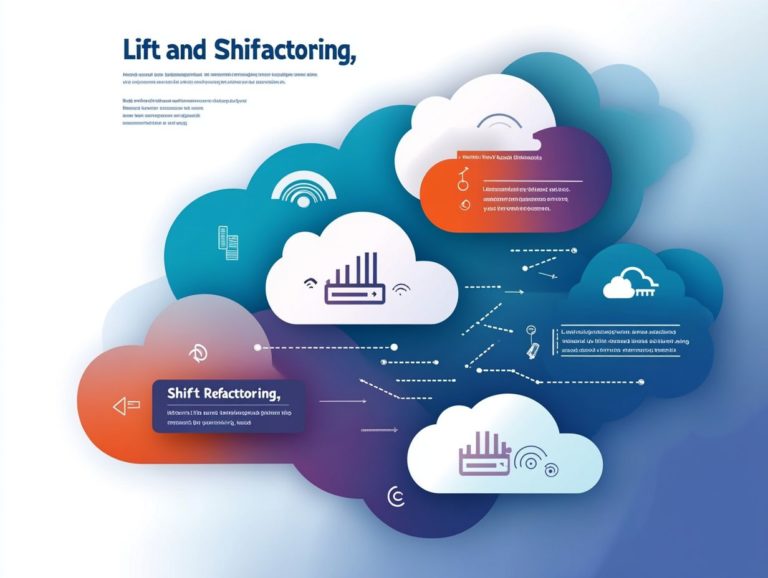The Importance of Vendor Lock-In in Hybrid Cloud
In today’s rapidly evolving digital landscape, hybrid cloud solutions are gaining traction among businesses like yours, all in pursuit of greater flexibility and scalability.
However, the appeal of a seamless hybrid cloud experience comes with a caveat: the risk of vendor lock-in. This scenario occurs when companies inadvertently tie themselves to a single cloud provider, creating potential challenges in the future.
This article explores the complexities of hybrid cloud solutions, highlighting the implications of vendor lock-in and its dual-edged nature. It will also provide you with insightful strategies to navigate this intricate landscape, enabling your business to maximize benefits while effectively mitigating risks.
Get ready to discover how vendor lock-in can influence your hybrid cloud success!
Contents
- Key Takeaways:
- Understanding Hybrid Cloud
- Understanding Vendor Lock-In: What You Need to Know
- The Role of Vendor Lock-In in Hybrid Cloud
- Pros and Cons of Vendor Lock-In in Hybrid Cloud
- Strategies for Dealing with Vendor Lock-In
- Frequently Asked Questions
- What is vendor lock-in in hybrid cloud and why is it important?
- How does vendor lock-in occur in hybrid cloud?
- What are the risks of vendor lock-in in hybrid cloud?
- How can companies avoid vendor lock-in in hybrid cloud?
- What are the benefits of avoiding vendor lock-in in hybrid cloud?
- How can companies handle existing vendor lock-in in hybrid cloud?
Key Takeaways:

Vendor lock-in happens when a company relies heavily on one cloud provider, making it tough to switch. While it can save money and be convenient, it might limit your flexibility and increase costs later.
To manage vendor lock-in in hybrid cloud, companies should carefully consider their options and have a strategy to mitigate risks and maximize benefits.
Understanding Hybrid Cloud
Hybrid cloud represents a crucial concept in modern cloud computing, allowing you to blend private and public cloud environments for improved flexibility and scalability.
This model enables you to harness the advantages of both private and public clouds while maintaining control over sensitive data and applications.
By utilizing different cloud providers and ensuring that various systems can work together, you can refine your IT strategies to meet diverse business needs effectively.
Application portability is essential for moving workloads seamlessly across these environments, ultimately boosting your overall efficiency and resource management.
Definition and Benefits
The hybrid cloud model offers an innovative mix of private and public cloud services, delivering unmatched flexibility and scalability tailored to your organizational needs.
This integration allows you to optimize your resources effectively, balancing workloads between your on-premises infrastructure and cloud services.
By adopting this approach, you can significantly reduce costs by utilizing public cloud services only for variable workloads during peak times.
The hybrid cloud enables you to quickly scale resources up or down in response to changing market conditions, helping you manage risks associated with fluctuations.
This adaptability streamlines operations and enhances your ability to respond swiftly to competitive pressures, ensuring you remain agile and cost-effective while harnessing the full potential of cloud services.
Understanding Vendor Lock-In: What You Need to Know
Vendor lock-in describes a situation where you rely on a specific cloud service provider, making it challenging and expensive to transition to a different vendor due to proprietary standards and contractual obligations.
This dependency can lead to high migration costs when it comes time to shift your data and applications to other platforms, presenting significant hurdles for IT professionals and organizations.
Furthermore, legal constraints around data ownership often complicate matters, restricting your ability to migrate resources effortlessly if you decide to explore other options.
Explanation and Implications

Vendor lock-in often emerges from the complex integration of various cloud vendors and their services. This situation can lead to considerable integration challenges and complicate data migration efforts.
This predicament typically leaves you tethered to a specific vendor’s ecosystem. Transitioning to alternative solutions becomes costly and time-consuming.
If you heavily rely on a particular cloud storage provider, you may face significant obstacles when migrating your data to another platform. Compatibility issues or proprietary formats often complicate this process.
Vendor lock-in stifles innovation. It restricts access to new tools, which reduces overall efficiency.
The consequences extend beyond mere migration challenges. You may find your data ensnared, unable to leverage the most effective integrations across platforms. This can significantly hinder your ability to swiftly adapt to changing market demands.
The Role of Vendor Lock-In in Hybrid Cloud
In the realm of hybrid cloud, the importance of vendor lock-in in IaaS is a critical factor that shapes cloud strategies and the selection of cloud providers. It significantly impacts service quality and overall business performance.
Act now! Assess your options carefully to avoid a single vendor trap that could stifle your growth and flexibility.
As hybrid cloud models evolve, understanding the challenges of vendor lock-in becomes essential for IT professionals like you. This understanding helps create an agile cloud environment that adapts seamlessly to your ever-changing business needs.
How it Affects Hybrid Cloud Adoption and Management
Vendor lock-in can significantly impact hybrid cloud adoption and management by creating dependency on a specific vendor. This dependency may hinder your ability to allocate cloud resources efficiently.
It often results in increased costs, as you may encounter penalties for migrating data or switching service providers. To combat these challenges, consider implementing a multi-cloud strategy.
This approach offers greater redundancy and choice, enabling you to distribute workloads across various platforms. Embracing open standards and containerization enhances interoperability, allowing smoother transitions between cloud environments.
By cultivating a culture of cloud-agnostic strategies, you can shield your organization from the pitfalls of vendor lock-in. This enables you to make more informed and strategic decisions in your cloud journey.
Pros and Cons of Vendor Lock-In in Hybrid Cloud
When you assess the pros and cons of vendor lock-in in hybrid cloud environments, you’ll uncover a nuanced landscape.
On one hand, you benefit from enhanced integration and tailored solutions that elevate your operations.
On the other hand, you face significant risks, such as increased costs and reduced agility, which could hinder your flexibility and responsiveness.
Benefits and Risks to Consider

Understanding the benefits and risks of vendor lock-in is essential as you navigate the complexities of cloud computing. This knowledge will guide your decisions regarding data ownership and cloud strategies.
When you entrust your data and infrastructure to a specific cloud provider, you often gain access to tailored services, enhanced performance, and seamless integration with your existing systems.
However, this situation can also lead to costly and complex migrations, potentially jeopardizing your data accessibility. Vendor lock-in may restrict your ability to innovate and adapt your cloud strategies in response to evolving technological trends and market demands.
A comprehensive understanding of these dynamics is crucial for maintaining control over your data sovereignty and ensuring that your long-term business objectives remain within reach.
Strategies for Dealing with Vendor Lock-In
To navigate the intricacies of vendor lock-in, you can adopt a range of strategies designed to mitigate risks while fully leveraging the advantages of cloud services.
This approach will enable you to maintain the flexibility and adaptability of your cloud policies, ensuring they align seamlessly with your organizational goals.
Evaluate your vendor relationships actively to stay ahead of potential challenges.
Mitigating Risks and Maximizing Benefits
Mitigating risks from vendor lock-in while maximizing benefits requires careful planning. Managing your cloud resources ensures flexibility and control.
Consider a multi-cloud strategy. This diversifies your service providers and reduces reliance on a single vendor.
Regular audits of your cloud usage help identify areas of over-dependence on one vendor.
By fostering a culture of continuous evaluation, you can adapt to changing needs. This empowers you to use your cloud resources more effectively and maintain autonomy.
Considering Vendor Lock-In in Hybrid Cloud Decision Making
Incorporating vendor lock-in considerations into your hybrid cloud decision-making process is crucial. This approach helps in crafting resilient cloud architectures and effective cloud strategies.
Acknowledging the potential risks of depending on a single cloud provider allows for informed choices. This enhances flexibility and adaptability within your IT infrastructure.
This foresight helps you avoid financial and operational traps associated with restrictive contracts. You can retain control over your data and applications.
Adopting a strategic approach to vendor selection enables you to leverage various platforms’ strengths. This optimization of resource allocation elevates overall performance, positioning your organization for long-term success in a rapidly evolving digital landscape.
Frequently Asked Questions

What is vendor lock-in in hybrid cloud and why is it important?
Vendor lock-in in hybrid cloud refers to a situation where a company becomes heavily dependent on a specific cloud service provider. This dependency can limit flexibility, increase costs, and hinder innovation, making it crucial to consider.
How does vendor lock-in occur in hybrid cloud?
Vendor lock-in can happen when a company relies on proprietary tools and services from a specific cloud service provider. This reliance complicates the transition to another provider without significant effort and cost. It also occurs when a company’s data and applications are tightly integrated with a specific provider’s platform.
What are the risks of vendor lock-in in hybrid cloud?
The risks include limited mobility and flexibility, potential cost increases, lack of innovation, and data security concerns. Additionally, it can lead to a company being at the mercy of the provider’s pricing and service changes.
How can companies avoid vendor lock-in in hybrid cloud?
To avoid vendor lock-in, companies should consider their cloud strategy carefully. Choosing providers that offer open and interoperable solutions and implementing a multi-cloud approach allows for greater flexibility and control over data and applications.
What are the benefits of avoiding vendor lock-in in hybrid cloud?
Avoiding vendor lock-in allows companies the freedom to choose the best solutions from multiple providers. This strategy can reduce costs, improve agility, and foster innovation. It also facilitates easier data and application portability, making transitions to new providers more manageable.
How can companies handle existing vendor lock-in in hybrid cloud?
If already locked into a specific cloud service provider, companies can still mitigate risks and reduce impact. This may involve negotiating better terms and pricing, implementing a workload portability strategy, and continuously evaluating other providers for future use.






